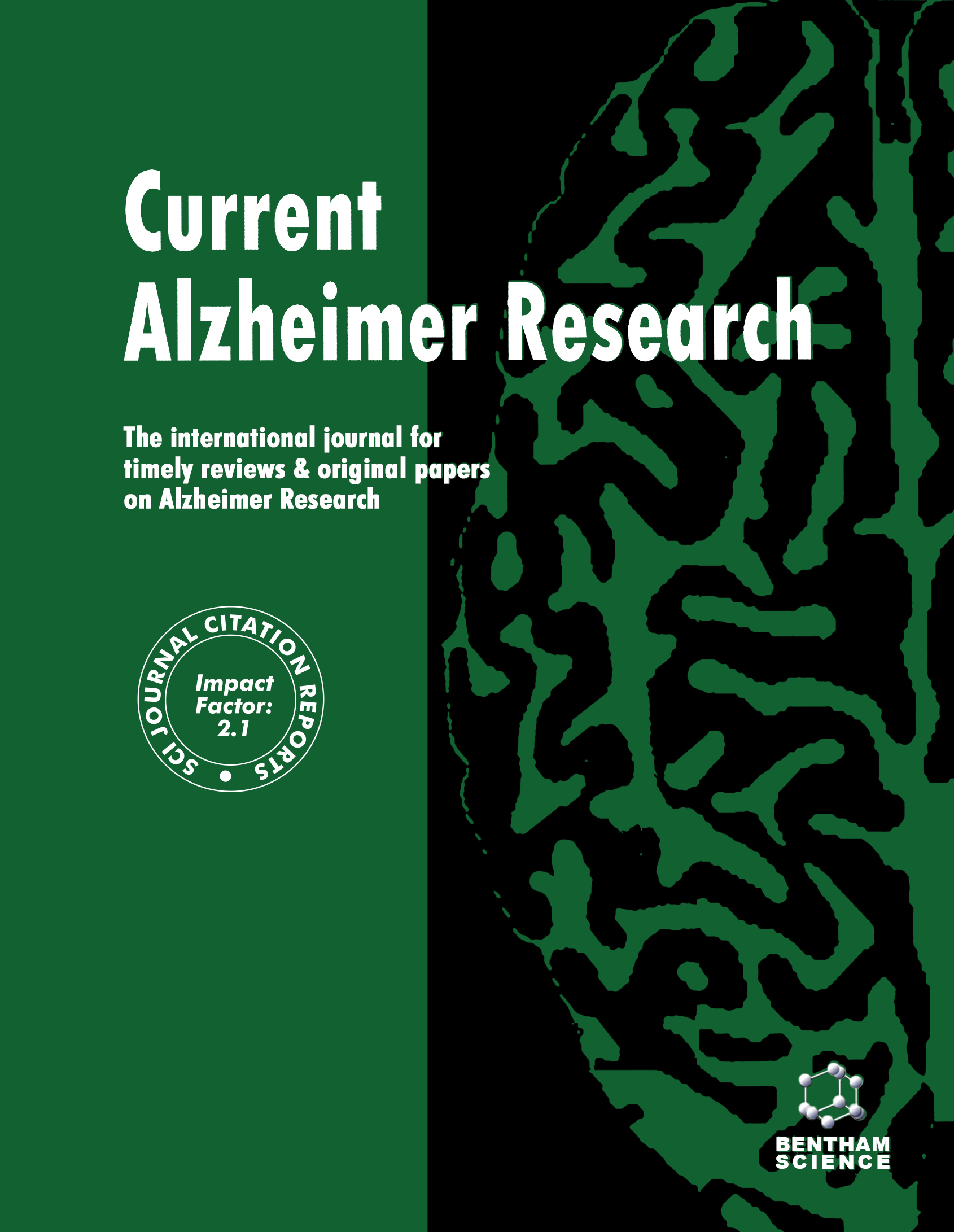- Home
- A-Z Publications
- Current Alzheimer Research
- Previous Issues
- Volume 7, Issue 6, 2010
Current Alzheimer Research - Volume 7, Issue 6, 2010
Volume 7, Issue 6, 2010
-
-
Alzheimer's Disease: SPECT and PET Tracers for Beta-Amyloid Imaging
More LessAuthors: V. Valotassiou, S. Archimandritis, N. Sifakis, J. Papatriantafyllou and P. GeorgouliasThe definite diagnosis of Alzheimer's disease (AD) is based on the detection of beta amyloid (Aβ) plaques and neurofibrillary tangles (NFTs) - which are the pathological hallmarks of the disease- in the postmortem brains. Although regional Cerebral Blood Flow (rCBF) and Cerebral Glucose Metabolism (CGM) abnormalities have already been studied in AD patients with Single Photon Emission Computed Tomography (SPECT) Read More
-
-
-
Diagnosis of Alzheimer's Disease from EEG Signals: Where Are We Standing?
More LessAuthors: J. Dauwels, F. Vialatte and A. CichockiThis paper reviews recent progress in the diagnosis of Alzheimer's disease (AD) from electroencephalograms (EEG). Three major effects of AD on EEG have been observed: slowing of the EEG, reduced complexity of the EEG signals, and perturbations in EEG synchrony. In recent years, a variety of sophisticated computational approaches has been proposed to detect those subtle perturbations in the EEG of AD patients. The paper Read More
-
-
-
Is Elevated Norepinephrine an Etiological Factor in Some Cases of Alzheimer's Disease?
More LessLoss of norepinephrine (NE) releasing neurons, in the locus coeruleus of the brainstem, is well documented to occur in Alzheimer's disease (AD). However, this process does not necessarily result in decreased release of NE, since compensatory mechanisms may produce increased release of this neurotransmitter. Independent of potential loss of locus coeruleus cells, brain NE levels may be elevated in some persons with AD, b Read More
-
-
-
Prevalence of Neuropsychiatric Symptoms in Mild Cognitive Impairment and Alzheimer's Disease, and its Relationship with Cognitive Impairment
More LessAuthors: M. Fernandez-Martinez, A. Molano, J. Castro and J. J. ZarranzObjective The study aimed to describe the prevalence of Neuropsychiatric symptoms (NPS) in Alzheimer's disease (AD), amnestic mild cognitive impairment (MCI) and controls using the 12-item Neuropsychiatric Inventory (NPI) and to analyze the relationships between neuropsychiatric symptoms with specific neuropsychological tests.Patients and methods; We prospectively studied 485 patients from the Memory Unit in Read More
-
-
-
Impacts of Hyper-Homocysteinemia and White Matter Hyper-Intensity in Alzheimer's Disease Patients with Normal Creatinine: An MRI-Based Study with Longitudinal Follow-up
More LessAuthors: C. W. Huang, W. N. Chang, C. C. Lui, C. F. Chen, C. H. Lu, Y. L. Wang, C. Chen, Y. Y. Juang, Y. T. Lin, M. C. Tu and C. C. ChangBackground: White matter hyper-intensities (WMHs) on magnetic resonance imaging (MRI) are commonly found in Alzheimer's disease (AD). Cerebro-vascular risk factors including plasma total homocysteine (tHcy) may result in WMHs. This study examined the association between tHcy and WMHs, and their effects on cognitive functions in AD patients over a two-year follow-up period. Methods: One hundred and fifty-sev Read More
-
-
-
Low Levels of High Density Lipoprotein Increase the Severity of Cerebral White Matter Changes:Implications for Prevention and Treatment of Cerebrovascular Diseases
More LessAuthors: M. Crisby, L. Bronge and L.-O. WahlundBackground and Purpuse: Cerebral White matter changes (WMC) are a frequent finding on CT and MRI scans of elderly individuals, particularly in those with vascular risk factors, cerberovascular disease, and cognitive impairment. Methods: 56 subjects were included in the study after the review of reports of more than 200 consecutive brain Computerized Tomography (CT) and magnetic resonance imaging (MRI) examinati Read More
-
-
-
Bone Marrow-Derived Mesenchymal Stem Cells Attenuate Amyloid β-Induced Memory Impairment and Apoptosis by Inhibiting Neuronal Cell Death
More LessAmyloid β (Aβ) peptide plays a central role in neuronal apoptosis, promoting oxidative stress, lipid peroxidation, caspase pathway activation and neuronal loss. Our previous study has shown that bone marrow-derived mesenchymal stem cells (BM-MSCs) reduce Aβ deposition when transplanted into acutely-induced Alzheimer's disease (AD) mice brain. However, the impact of reduced Aβ deposition on memory impai Read More
-
-
-
Ubiquitin Enzymes, Ubiquitin and Proteasome Activity in Blood Mononuclear Cells of MCI, Alzheimer and Parkinson Patients
More LessAuthors: C. Ullrich, R. Mlekusch, A. Kuschnig, J. Marksteiner and C. HumpelAlzheimer's disease (AD) is a severe chronic neurodegenerative disease. During aging and neurodegeneration, misfolded proteins accumulate and activate the ubiquitin-proteasome system. The aim of the present study is to explore whether ubiquitin-activating enzyme E1, ubiquitin-conjugating enzyme E2, ubiquitin or proteasome activity are affected in peripheral blood mononuclear cells (PBMC) of AD, mild cognitive impairment Read More
-
-
-
Atheromatosis Extent in Coronary Artery Disease is not Correlated with Apolipoprotein-E Polymorphism and its Plasma Levels, but Associated with Cognitive Decline
More LessBackground: Apolipoprotein-E (apoE) ε4 allele is a known risk factor for Alzheimer's disease (AD). Polymorphism of apoE is also one of the most important genetic markers for coronary artery disease (CAD). The allelic variation in the apoE gene has a significant effect on inter-individual variation of lipids and lipoprotein plasma levels as well. This study investigated whether apoE polymorphism affects the plasma levels of Read More
-
Volumes & issues
-
Volume 21 (2024)
-
Volume 20 (2023)
-
Volume 19 (2022)
-
Volume 18 (2021)
-
Volume 17 (2020)
-
Volume 16 (2019)
-
Volume 15 (2018)
-
Volume 14 (2017)
-
Volume 13 (2016)
-
Volume 12 (2015)
-
Volume 11 (2014)
-
Volume 10 (2013)
-
Volume 9 (2012)
-
Volume 8 (2011)
-
Volume 7 (2010)
-
Volume 6 (2009)
-
Volume 5 (2008)
-
Volume 4 (2007)
-
Volume 3 (2006)
-
Volume 2 (2005)
-
Volume 1 (2004)
Most Read This Month
Article
content/journals/car
Journal
10
5
false
en

Most Cited Most Cited RSS feed
-
-
Cognitive Reserve in Aging
Authors: A. M. Tucker and Y. Stern
-
- More Less

